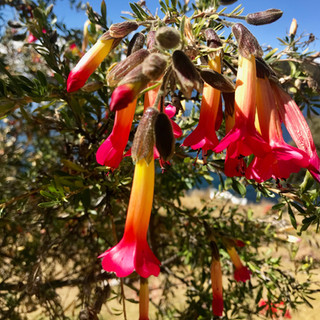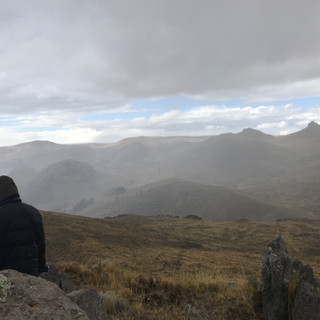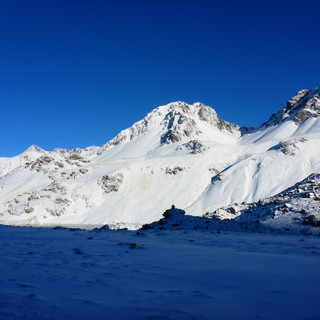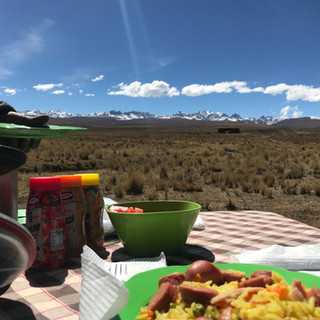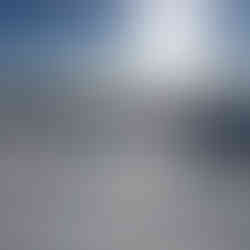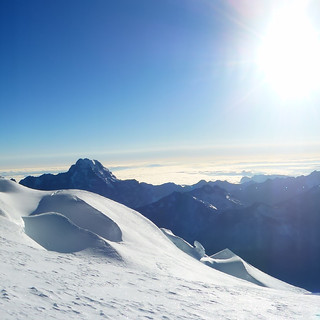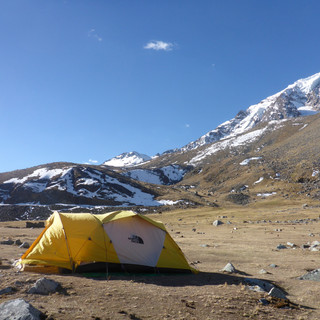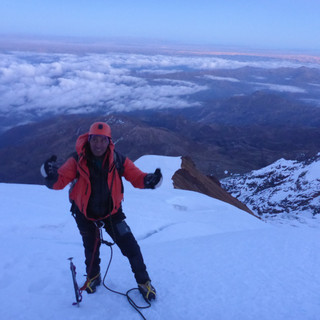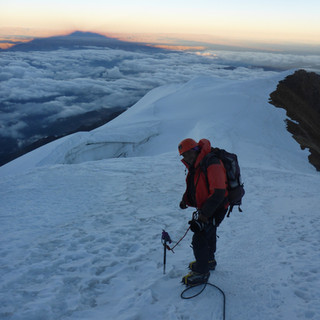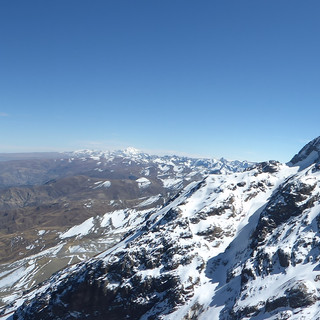Having had a great time climbing in Nepal in 2015, I was keen to extend my climbing skills with a view to one day tackling Mt McKinley in Alaska or Ama Dablam in Nepal. Earlier this year I was looking at different options and then I saw a climbing itinerary in Bolivia that would involve climbing four mountains in three weeks. The climbs would vary in technical difficulty and include more advanced ice climbing than what I had experienced in Nepal. To top it off, the mountains were all highly accessible, all within a few hours drive of La Paz. Karen told me to 'go for it'. I was in!
So, on 15 July I headed to Santiago in Chile and then on to La Paz the next day. La Paz is at an elevation of 3,600m and the neighbouring city of El Alto at 4,000m. It took us a solid 10 days of hiking in Nepal to reach these altitudes!
After a couple of days in La Paz we headed to Lake Titicaca (4,000m) to further acclimatise and learn more about the fascinating history and culture of the high Andes. At this point, I should clarify who is 'we'. Having booked on a group expedition with World Expeditions, unfortunately no one else signed up for this trip, so they offered me the option of having a private tour. I could see the pros and cons of this and, after weighing it up, decided to go ahead.
Having a dedicated guide was great. Rudy was my cultural guide for La Paz, Lake Titicaca, Copacabana and the Island of the Sun and his knowledge was exceptional. Jose (otherwise known as Chapaco) was my mountain guide for Condoriri and Huayna Potosi and, finally, Juan was my mountain guide for Illimani. Juan was also the owner of the local agency (Azimut Explorer) that managed the World Expeditions trips in Bolivia. For all my time in the mountains, we were also joined by Pancho, our fantastic cook (who also assisted in climbing on Illimani). Ramiro was our main driver as we spent many hours driving between climbing regions, mostly with Jose, Pancho and Ramiro singing along to the latest Bolivian hit songs.
After a few fun days sightseeing around Lake Titicaca, it was time to make our way to the mountains. Our first destination was Condoriri Valley. The night before arriving in Condoriri, we had been in Copacabana and an enormous storm had lashed the town - plunging the hotel into darkness for many hours. When we arrived into Condoriri, the storm was still present. We made the hour-long hike to base camp through a hail storm.
The next day more snow was falling but nonetheless we set off for our first summit, Pico Austria or sometimes called Cerro Negro. What would have been a straightforward hike up to 5,350m became more challenging as the conditions worsened with heavy snow falls. We made good time to the summit (3.5 hrs) but found the return difficult and slippery due to the snow conditions.
Snow fell all afternoon and that night gale force winds battered my tent. However, the next day, the winds calmed to reveal beautiful clear skies. We spent a few hours on the glacier undertaking some basic alpine skills training, including abseiling into a deep crevasse, where you could hear a stream flowing deep below. We met a number of groups coming off the glacier after having attempted to summit Pequeno Alpamayo. Most had been turned back due to the deep snow on the glacier. One group had taken 8 hours to reach Pico Tarija.
We set out at 3am for our summit attempt of Pico Tarija and then Pequeno Alpamayo. The night was beautiful and clear with no wind. It was an hour to the glacier and then 2.5 hours to the summit of Pico Tarija. It was hard going in calf-to-knee deep snow. We were also the one group on the mountain this morning, which was unusual as we had watched multiple groups over the preceding days make their way up the glacier. Being the only people on the mountain was a really special experience.
From the summit of Pico Tarija we had to climb down a steep and rocky path to a snowy ridge that would connect across to Pequeno Alpamayo. The climbing was exposed but incredibly beautiful as first light appeared over the Andes. From here, it was hard steep and exposed climbing to the summit that we tackled as 3-4 separate pitches. At 9:30am we reached the summit and were rewarded with spectacular views over the range - with Huayna Potosi, our next objective, clearly in sight.
We struggled through waist deep snow on our return and finally reached camp at 11:30am. Despite the tough conditions, we had made good time and had a great adventure. I had been pushed well and truly out of my comfort zone on the steeper and more exposed parts of the route. Jose did a great job in keeping the climbing safe and improving my skills and confidence at the same time.
The next day we headed back down the valley to meet our car. It was another stunning day as evidenced by the photos.
After a night in La Paz, we headed out to Huayna Potosi base camp. Huayna Potosi has alpine refuges at both base camp and high camp, which means no tents were required. However, you needed to be comfortable with communal living and sleeping.
While it was only 2.5 hours from base camp to high camp, it involved an ascent of 800m and was very steep, involving switch backs up a rocky and snowy ridge. The last 1.5 hours into high camp we used our crampons. High camp was wedged on a rocky ridge just before the start of the glacier. Where the refuge at base camp had been freezing cold - constantly caught in the shadow of the mountain - high camp was exposed to direct sun and was akin to a sauna. I spent the afternoon in the refuge talking with the other climbers (the first time I had met other English speaking climbers on the trip) and relaxing ahead of the summit push early the next morning.
Jose and I decided to leave last out of the high camp refuge. Most groups left between 1am and 2am. We headed off at 2:30am (although had originally planned to leave at 3am) in perfect conditions - clear skies, compacted snow on the glacier and no wind. There were at least 10 other groups on the mountain. We moved quickly up the glacier and overtook half of the other climbers by the time we reached the steeper headwall. We kept moving quickly and were soon making our way up the final steep switch backs to the summit. We had to slow down on the last stretch to the summit as we were too early for sunrise! As it was we were the second group to summit that morning and had to wait 20min on the summit for the sun to rise!
First light and then the arrival of the sun was unforgettable. We watched the shadow of the mountain stretch over Lake Titicaca. We could also see the thick clouds hanging over the Amazon rainforest to the East. The descent was equally as spectacular, with the early morning sun and clear skies highlighting the glacier features that had been hidden in the darkness of the early morning ascent. Walking down the glacier, Illimani - our final objective - loomed large in front of us!
After a rest day in La Paz, we were on our way back to the mountains. The drive to Illimani base camp was an adventure in itself. Bolivia has the dubious title of having the 'Most Dangerous Road in the World' and I could see how. The dirt road to Illimani wound its way across steep valleys and ravines, linking the small villages that farm the fertile slopes of the mountain. Illimani is an imposing mountain, clearly visible from most parts of La Paz.
After 4 hours of bone rattling dirt roads, we finally came to base camp - a beautiful open meadow sitting below the steep rocky ridge where high camp sits. Alpacas, lamas, sheep and horses all grazed in the meadow surrounding base camp.
From base camp, it was a hard day's hike to high camp - called the Condors Nest. From base camp (4,600m) we made our way to 5,000m for lunch after 2 hours of solid hiking. The next 500m of elevation gain involved a very steep ascent up a rocky ridge. After over 2 weeks of climbing, there is no doubt that this was hard going. I arrived at high camp at around 3pm. The setting for high camp was spectacular and definitely worth the effort. Condors and falcons were playing in the updrafts surrounding high camp - which is wedged between a rocky cliff and the glacier. It was evident from high camp that the route to summit was going to be very steep, straight out of camp!
On our way to high camp, we had met three groups returning from their summit attempt. All groups had turned around at 'La Bola' - the final steep headwall. The ice on the headwall was very hard, making protecting it difficult. One group had also felt cracking of the glacier near the crevasse at the base of La Bola. This didn't bode well for our own summit attempt.
We headed off at 3am and, as expected, it was steep and hard going right out of camp. The conditions were very icy. I became very familiar with the Spanish word 'hielo' - icy. Juan and Pancho protected a number of short sections where it was icy and exposed. After 3.5 hours we reached c.6,100m and was just below the La Bola headwall. We decided that it would not be safe to attempt La Bola in these conditions and so we reluctantly turned around, just 300m from the summit.
We returned to high camp at 8:30am and, after a short rest, started the steep descent to base camp. In total, we had ascended 750 vertical meters and descended a 1,850 vertical meters in 10 hours. Despite not reaching the summit, the views had been spectacular and it had been a real adventure.
Returning to La Paz for the last time, I was exhausted but thankful for an amazing experience in Bolivia. After a couple of days to recover I started the long journey home to see the family.
Stopover in Santiago, Chile
Flight to La Paz, Bolivia
La Paz
Lake Titicaca - Island of the Sun
Copacabana
Mountain on Border of Peru and Bolivia - Rain, Hail and Shine (but no path)
Condoriri - Before the Snow
Condoriri - After the Snow.
First Summit: Pico Austria (5,320m)
Alpine Skills Training - Condoriri
Pequeno Alpamayo (5,425m)
Condoriri - Walking Down the Valley
Huayna Potosi - High Camp
Huayna Potosi - Summit (6,088m)
Huayna Potosi - Descent
Illimani - To Base Camp
Illimani - To High Camp
Illimani - Summit (well almost, 6,200m)
To check out my specific route maps for each mountain: Click here.

































































































